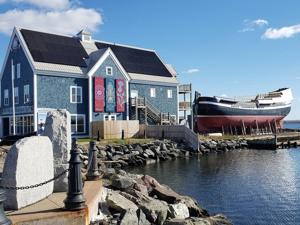Health
Historic Hector Ship Set for Relaunch After Major Restoration

A restored replica of the square-rigged sailing ship Hector, which played a pivotal role in the Scottish immigration wave to Nova Scotia, is poised for a significant relaunch. This event will take place in the harbour of Pictou, where the original vessel arrived over 250 years ago. The relaunch ceremony is scheduled for Saturday, marking the culmination of a comprehensive restoration project that began in 2019.
The rebuilt hull of the Hector will be launched sideways into the water during a traditional ceremony. The vessel will glide down seven launchways after supporting wedges are removed, a process described by master shipbuilder Vern Shea as a breathtaking sight. “I’ve witnessed quite a few launches in my career, and you always get the hair on the back of your neck rising and the goosebumps every time you see it,” Shea stated in a recent interview.
Originally constructed in 2000, the Hector replica was built using traditional methods based on original designs. However, it fell into disrepair over the years due to inadequate maintenance. The Ship Hector Society acquired the vessel from the town of Pictou in 2010 for a nominal fee. Since then, the society has spearheaded a fundraising campaign that has raised $4 million for the restoration, aiming to transform the Hector into a fully operational sailing vessel.
Shea, who was also involved in the engineering drawings for the rebuild of Nova Scotia’s iconic Bluenose II, noted that the latest restoration required extensive work. “We replaced all of the rotten planks up to the main deck with Douglas fir planking and then we filled the seams with pine and used two layers of fibreglass,” he explained.
Inside the hull, two cramped compartments have been recreated to reflect conditions from 1773 when the Hector carried 189 passengers on a harrowing 11-week voyage. This journey was marked by tragedy, as smallpox claimed the lives of 18 of the settlers. Shea remarked on the challenging conditions that the original passengers faced, stating, “It would have been cramped and it would have been putrid and it would have been disgusting.”
The Ship Hector Society emphasizes the historical significance of the vessel on its website, highlighting how those who arrived aboard the Hector, along with subsequent Scottish settlers, made substantial contributions that shaped Nova Scotia and Canada. This historic voyage initiated a significant wave of immigration, earning Pictou the title of “The Birthplace of New Scotland.”
Following the relaunch, the next phase of the project will focus on installing electric motors, masts, and sails. The society aims to have the newly refurbished Hector ready for harbour tours by 2027. Currently, just over $2 million in public funds has been raised, with an additional $1.8 million needed to complete the ship.
The interpretive centre, which recently underwent an extensive revamp funded by federal and provincial governments, opened last month. This centre tells the intertwined stories of the Scottish settlers and the local Mi’kmaq inhabitants through interactive displays and a new panoramic theatre presentation. Society chair Wes Surett emphasized the centre’s role in educating visitors about the survival of both cultures.
Looking ahead, the site plans to introduce a sailing program and a wooden shipbuilding school. However, Surett believes that a functional Hector will be the key to long-term sustainability for the attraction. “We see it (the ship) and that sailing experience generating the revenue to sustain the attraction long-term,” he stated.
This restoration project highlights the importance of preserving maritime heritage while also contributing to the cultural narrative of Nova Scotia. With the Hector set to sail once again, it promises to be a significant chapter in the ongoing story of Scottish immigration and its lasting impact on the region.
-

 World1 month ago
World1 month agoScientists Unearth Ancient Antarctic Ice to Unlock Climate Secrets
-

 Entertainment1 month ago
Entertainment1 month agoTrump and McCormick to Announce $70 Billion Energy Investments
-

 Science1 month ago
Science1 month agoFour Astronauts Return to Earth After International Space Station Mission
-

 Lifestyle1 month ago
Lifestyle1 month agoTransLink Launches Food Truck Program to Boost Revenue in Vancouver
-

 Sports1 month ago
Sports1 month agoSearch Underway for Missing Hunter Amid Hokkaido Bear Emergency
-

 Technology1 month ago
Technology1 month agoFrosthaven Launches Early Access on July 31, 2025
-

 Politics2 weeks ago
Politics2 weeks agoUkrainian Tennis Star Elina Svitolina Faces Death Threats Online
-

 Entertainment1 month ago
Entertainment1 month agoCalgary Theatre Troupe Revives Magic at Winnipeg Fringe Festival
-

 Politics1 month ago
Politics1 month agoCarney Engages First Nations Leaders at Development Law Summit
-

 Entertainment2 weeks ago
Entertainment2 weeks agoLeon Draisaitl Marries Celeste Desjardins in Lavish Ceremony
-

 Health1 month ago
Health1 month agoCMS Proposes New Payment Model to Enhance Chronic Disease Care
-

 Top Stories3 weeks ago
Top Stories3 weeks agoSuspect Identified in Maple Ridge Tragedy; Community in Shock





















